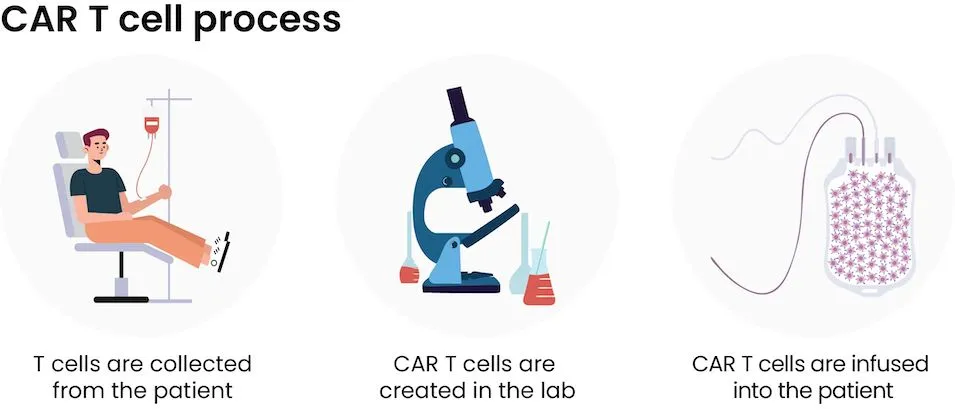CAR T-cell Therapy
The CAR T-cell therapy lisocabtagene maraleucel (liso-cel, Breyanzi) is an FDA-approved, one-and-done infusion for CLL. Although CAR T-cell therapy is not often referred to as a fixed-duration treatment, the one-time infusion will be grouped in this section of the guide.
When is CAR T-cell Therapy Used for CLL?
Liso-cel (Breyanzi, BMS) is FDA-approved for people with CLL who have received prior treatment with both a BTK inhibitor such as zanubrutinib, acalabrutinib, ibrutinib, or pirtobrutinib, and a BCL-2 inhibitor like venetoclax.
You don’t necessarily need to have become refractory to those treatments (meaning the cancer cells became intolerant to the therapies); you need to have received those medicines before starting CAR T-cell therapy.
How CAR T-Cell Therapy Works
Chimeric antigen receptor (CAR) T-cell therapy is a type of immunotherapy that helps an individual’s T-cells become efficient at destroying cancer.
CAR T-cell therapies are tailored to each patient by collecting their T-cells and modifying them in a lab. This process equips the T-cells with chimeric antigen receptors (CARs) on their surface. These CARs are designed to detect and attach to specific proteins, known as antigens, on the surface of cancer cells.
The steps of CAR T-cell therapy include:
- Collect some of the patient’s blood to gather T-cells
- Make CAR T-cells in the lab by inserting the CAR gene
- Grow millions of CAR T-cells in a lab
- Infuse CAR T-cells into the patient
- CAR T-cells bind to cancer cells and kill them

How Effective is Liso-cel for CLL?
In the case of liso-cel, it takes approximately 36 days from the request until the CAR T-cell therapy is ready for administration.
In the TRANSCEND CLL 004 study, 44% of patients experienced either a partial or full reduction in CLL cells (response) after a single infusion of liso-cel. 20% of these cases were a complete response (two months after treatment, patients' blood counts returned to normal, and their spleen and lymph nodes were not enlarged). On average, the patients who achieved a complete response remained in remission at the check-in point of 24 months.
It’s possible that liso-cel will not work for you. This may be because of T-cell exhaustion, inefficiency of CAR T-cells, or advanced mutations in CLL cells (changing the membrane protein the CAR-T binds to).
Side Effects of Liso-cel for CLL
Short term effects
After the liso-cel infusion, you may be monitored either as an outpatient or inpatient for side effects, depending on the institution where you were treated.
Some people may experience temporary side effects like cytokine release syndrome (CRS) and brain-related side effects (neurotoxicity). However, most individuals quickly recover with the help of in-clinic medicines.
Long term effects
The majority of CAR T-cell therapy side effects are short-term. The side effect with a long-term impact is called B-cell aplasia, which refers to a decrease in healthy B-cells.
This happens because the surface protein CD19 that liso-cel binds to on CLL cells is also present in healthy B-cells. As CAR T-cells continuously circulate the body, they can continue killing CLL cells long after they are infused, but they continuously affect the levels of healthy B-cells, too.
The low B-cell numbers, especially in the long term, may increase your infection risk. People with CLL who receive CAR T-cell therapy may be advised to receive a monthly immunoglobulin infusion called IVIG to help mitigate the risk of infections. You may also receive preventative antivirals, antifungals, and antibiotics.
Percentage of People with CLL/SLL Who Experience Mild-Moderate (Grade 2 or Less) Versions of CRS and ICANS After Liso-cel (based on the TRANSCEND-CLL study)
| Side Effect | Percentage of Patients Affected |
| Cytokine release syndrome | 74% |
| Encephalopathy (altered brain function, a feature of ICANS/neurotoxicity) | 26% |
For more information on this treatment and its side effects, visit Breyanzi's Medication Guide.
Financial Resources for Liso-cel
To locate financial resources for liso-cel, click here or visit the financial support section of the guide.